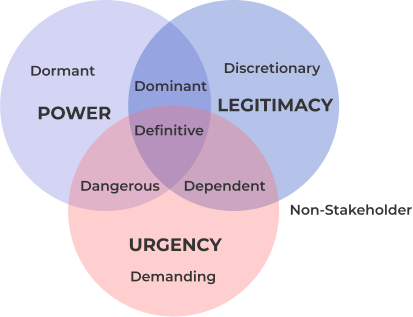Use this model when:
The Salience Model of stakeholder management emphasizes three dimensions to assess stakeholders: power, legitimacy, and urgency. These dimensions help prioritize stakeholders based on their importance and influence on a project or organization. Here's a breakdown of each dimension:
- Power: ower refers to the ability of a stakeholder or stakeholder group to impose their will, even in the face of resistance from others. It can stem from various sources such as control over resources, expertise, formal authority, or the ability to mobilize support. High-power stakeholders typically have the capacity to significantly affect the organization or project's activities and outcomes.
- Legitimacy: Legitimacy relates to the perceived appropriateness or validity of a stakeholder's claim to a stake in the organization or project. Stakeholders with high legitimacy have a rightful or justified interest in the organization's activities, often based on their role, status, or relationship with the organization. Legitimacy can be conferred by legal, moral, social, or contractual norms.
- Urgency Urgency refers to the degree to which a stakeholder's claims or expectations require immediate attention or response. Urgent stakeholders often have time-sensitive needs, issues, or concerns that must be addressed promptly to prevent negative consequences or capitalize on opportunities.
Based on these three dimensions, stakeholders can be classified into eight categories:
- Definitive Stakeholders: possess high power, legitimacy, and urgency. They are critical to the organization or project's success and require immediate attention and engagement.
- Dominant Stakeholders: have high power and legitimacy but may not exhibit the same level of urgency. While they have significant influence, their claims may not always be pressing.
- Dangerous Stakeholders: have high power and urgency but may lack legitimacy. They can pose significant risks or threats to the organization if their concerns are not addressed, but their claims may not be considered legitimate by others.
- Dependent Stakeholders: have high legitimacy and urgency but may lack power. They rely on the organization for support or resources and may require assistance to address their urgent needs.
- Demanding Stakeholders: have high power and legitimacy but lower urgency. While they have significant influence and legitimate claims, their issues or concerns may not require immediate attention.
- Discretionary Stakeholders: have legitimacy and power but low urgency. They may not require immediate attention, but their support or involvement can contribute positively to the organization or project.
- Dormant Stakeholders: have legitimacy but lack power and urgency. They may have been influential or involved in the past but are currently inactive or disengaged. While they may not require immediate attention, their potential to reengage should not be overlooked.
- Non-stakeholders: Non-stakeholders have low power, legitimacy, and urgency. They do not have a significant impact on the organization or project and typically do not require active engagement or attention.
By applying this model, you can identify and prioritize stakeholders based on their salience and develop tailored strategies for engaging with each group. This approach helps ensure that resources are allocated effectively and that you can address the needs and expectations of your most important stakeholders.
